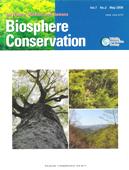A study on the habitat selection and forest edge use of Japanese monkey (
Macaca fuscata) was conducted between November 1991 and September 1994 in the Nikko and Imaichi area, central Honshu, Japan. Three monkey troops were radio-tracked and the location data were split into two seasons (leafy/leafless season) for the habitat selection analysis. Vegetation cover was measured from forest edge to its interior to quantify the change of food availability in terms of distance from the edge. Results showed that throughout the year deciduous broad-leaved forests were preferred (leafy season; x^2=93.5, df=5, p<0.001: leafless season; x^2=95.4, df=5, p<0.001), whereas evergreen coniferous plantations were neither preferred nor avoided. Monkeys preferred the forest edges, especially, within 50m from the edge, of all forest types except deciduous broad-leaved forests. In the leafy season, monkeys used deciduous forest edges in accordance with its availability up to 200m interior from its edge. Concentration of understory cover to its forest edge was most distinct in coniferous evergreen plantations. Habitat use patterns corresponded with seasonal food resource distribution patterns in each forest type. When monkeys used agricultural lands, the forest edges and agricultural lands might function to provide cover and food sources, respectively. Thus, in addition to the value of resources provided by singular habitat types, combinations of different habitat types may increase the variety of available resources for Japanese monkeys.
抄録全体を表示
